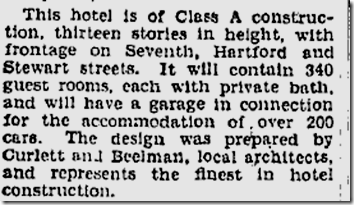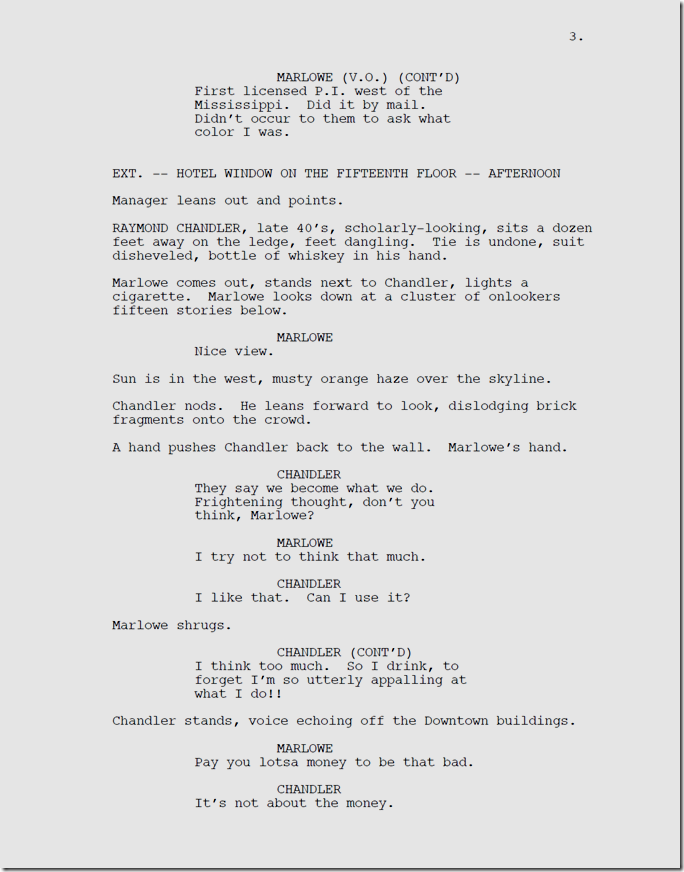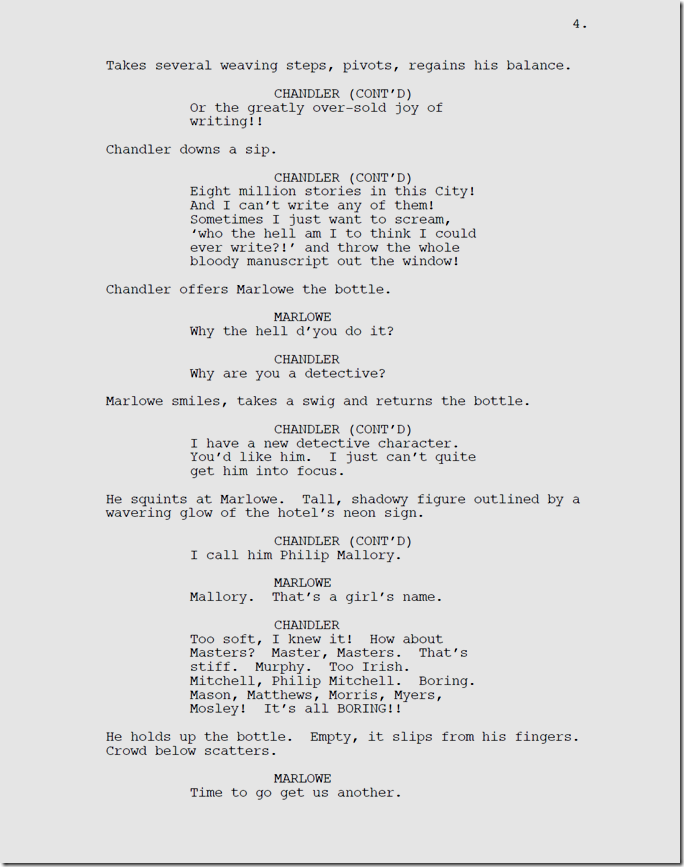
Someone asked me what I thought of this article in our hometown paper and when I got done laughing I pulled out Frank MacShane’s “Selected Letters of Raymond Chandler” and “The Life of Raymond Chandler.”
You guessed it.
Then, just for fun, I searched “The Selected Letters of Dashiell Hammett.”
Right again.
Here’s the pitch: In 1930s Los Angeles, hip, smooth, worldly African American private detective Samuel B. Marlowe helps out the struggling Raymond Chandler and Dashiell Hammett on how to write detective stories.
Never mind that Hammett actually worked as a detective early in his life. Never mind that Chandler made a clinical analysis of Hammett’s work and dissected the writing of Erle Stanley Gardner. Never mind that Chandler had labored for years at the craft of writing and had been published as a poet as early as 1908.
Etc.
Etc.
Etc.
Stripped of pseudo hardboiled writing (so hard to do well, so easy to do badly) and the mad chase for the Chandler/Hammett letters that somehow, mysteriously, gee whiz we can’t find them, but they’re real, trust me, honest, we have:
Louise Ransil — identified by Times writer Daniel Miller as “a former executive with Orion Pictures and New Line Cinema who lived alone in a penthouse with a pet parrot” and by imdb as an assistant to the producer on six episodes of “Cagney & Lacey” and secretary to the producers on “Son-Rise: A Miracle of Love” — has a script to sell.
(Update: A search of Variety’s online archives returns exactly one mention of Louise Ransil, on Dec. 18, 1981.)
It is titled “Marlowe” and it is available online. I got as far as Pages 3-4, in which Samuel B. Marlowe talks a drunk Raymond Chandler off the 15th-story ledge of the Mayfair Hotel.

Bonus points for inaccuracy: The Mayfair Hotel at 7th and Hartford has 13 stories, courtesy of Google Street View.

Los Angeles Times, Sept. 26, 1926: This hotel is of Class A construction, thirteen stories in height.
Chandler raves:
Eight million stories in this city! And I can’t write any of them! Sometimes I just want to scream, ‘who the hell am I to think I could ever write?!’ and throw the whole bloody manuscript out the window!
Oh please.
My next step is to check with the cemeteries in Gloucester, Mass., to see if MacShane is rolling over in his grave. Then again, it might be a good day for a drive down to Mount Hope Cemetery in San Diego to check for any unusual activity at the Chandler plot.





Nothing boring about Mosely … Walter, that is 🙂
LikeLike
Yep, they can put it over on Editorial, but they can’t fool Fact Cop Harnisch. When I read the story I thought it was just another iDiot email gone viral.
LikeLike
For the record, checking “Letters: Raymond Chandler and James M. Fox,” McShane’s “The Notebooks of Raymond Chandler,” and Gardiner & Walker’s “Raymond Chandler Speaking” yields … you guessed it.
LikeLike
The important thing to remember is correspondence at that time was far more formal than it is today with email. Chandler and Hammett, as longtime, experienced writers, knew to keep carbons of their correspondence and manuscripts in case the originals got lost. Chandler, according to Frank MacShane, frequently dictated his correspondence. In other words, there is a paper trail.
LikeLike
Yes, there are paper trails for both Chandler and Hammett — but like any trails, you have to know how to read and interpret them, to understand what they can and can’t tell you, and also realize that virtually NO ONE’s correspondence archive is 100% complete. Did Chandler *always* dictate his letters? Did these two writers *never* dash off a handwritten note or letter (of which carbons were seldom made), or a missive that was so personal or intimate that the making of a copy was never even considered? We have no way of knowing this. History (literary and otherwise) is chock-full of examples of letters being burned, destroyed, hidden, lost, etc. (Chandler himself is known to have destroyed all correspondence between his wife and himself.) So Samuel Marlowe’s non-appearance in the selected/collected/edited/published letters of either R.C. or D.H. — which represent just fractions of their *surviving* letters — proves absolutely nothing. (Don’t get me wrong. I’m skeptical of many elements of this story, just as you and others are — but the absence of evidence is not, in itself, evidence of absence.)
LikeLike
By that argument, you could say that Samuel B. Marlowe also offered writing guidance to William Faulkner, Ernest Hemingway, Ayn Rand, Ray Bradbury and Louis L’Amour. Maybe even Barbara Cartland! The fact that we can’t find the slightest trace of it is insignificant if someone peddling a screenplay says it’s so.
LikeLike
You haven’t carefully read the biographies. Hammett was a wanderer, living largely in hotels, keeping very little.of anything. And Chandler burnt the bulk of his paperwork, including years worth of creative notebooks, in deep depression after Cissy died. Published correspondence is mostly the letter collections donated to the UCLA and Oxford archives.
There are many other collector’s pieces of correspondence frequently changing hands and auctioned off. A new piece of correspondence turned up last year, a letter Chandler wrote to a fan.
LikeLike
Forgive my skepticism, but what you are claiming aren’t inconsequential thank-you notes or random fan letters.
You are saying that this gentleman was so influential on two major American authors (now conveniently dead and unable to refute your claims) that they named their characters after him and that he carried on a correspondence with both of them over a period of time. With zero proof other than your say-so. There are apparently no extant letters or files and absolutely no independent confirmation from anybody who ever knew Chandler or Hammett.
Certainly if Samuel B. Marlowe had played so significant a role in Chandler’s creative life, Frank MacShane (also conveniently dead and unable to refute your claims) would have made some reference to it.
The only support appears to be from people with something to gain in the sale of your script.
With all due respect, the burden of proof is entirely upon you to provide concrete evidence to prove the authenticity of your rather dubious claims.
LikeLike
There are many hotel sites online listing the Mayfair and its amenities. They all list the hotel with 15 floors. Pull up those sites and look.
LikeLike
Pardon my skepticism, but the 1926 Times story on the Mayfair’s construction says it has 13 stories.
LikeLike
Yes, and if you look at the picture accompanying that very Times story you cite, you can count the floors: 14. And given the longstanding (superstitious) tradition of buildings not having a “13th floor,” the actually-14th floor of the Mayfair may well have been designated as the “15th.” (But this is a silly point to argue, and whether Ms. Ransil gets a trivial point like this “wrong” or “right” in her script is irrelevant.)
LikeLike
Read all the sites advertising the Mayfair as having 15 floors. The top floor is referred to as “the 15th floor”. Room numbers start with the number 15.
If you’re going to pick apart minor facts trying to disprove the story, you should at least get them right.
By the way, the L.A. Times talked to a number of people who saw the files and letters, and heard the stories before I did. Some of this is a matter of court record, but that’s not as much fun as leaving it all a bit mysterious. This article was written to fit a certain style, but realize the L.A. Times does not spend a year-and-a-half working on an article that has no substantiation.
LikeLike
Are we to assume that a screenwriter working on a script “based on a true story” relied upon online research rather than actually visiting the location to ensure the details were correct? Possibly that’s why the photo of the Mayfair Hotel doesn’t show a ledge, as referred to in your screenplay.
LikeLike
All the advertising does not list the Mayfair as 15 stories. The original owners bought a large ad in the February 1, 1927 Los Angeles Times, proudly proclaiming the grand opening of their “13 story building.” And, if you go to the Mayfair’s website, there are both historic and contemporary photos showing a 2 story lobby. Here it is:
http://www.mayfairla.com/gallery/
LikeLike
The phone number for the Mayfair Hotel is 213 632-1200. Call them. I just did to ask them how they refer to their top floor. The operator referred to it as “the 15th floor”.
And for the record, there were two original ledges removed from the exterior of the building during the 1980 renovations. But in truth, Raymond Chandler was sitting with his feet dangling out the window, threatening to jump if anyone came near. (You’ll find mention of the incident in at least one of the biographies, if you care to read them carefully.) And yes, I moved the scene out onto the window ledge to make it more dramatic. Sorry, that’s Hollywood.
But I do like your logic. If you can find small technical discrepancies, it must mean the story is a fake.
LikeLike
Madam, you said it yourself: “That’s Hollywood,” a place full of hangers-on and industry wannabes trying to cash in with ridiculous, unsubstantiated stories about conveniently dead celebrities, as in Scotty Bowers’ “Full Service.”
LikeLike
But obviously it’s not the 15th floor, if it’s a two story lobby. As the original owners stated, 13 story building, because only 13 stories could be rented out, not 15.
LikeLike
And if you had done any historic or architectural research, you would realize that the top floor of a hotel lobby is not a floor, but a mezzanine, as it is in the Roosevelt and the Biltmore. That means the second floor is above it; therefore once again, it cannot be a 15 story hotel.
LikeLike
Philip Marlowe was named after Marlowe House in Dulwich College, where Chandler (and P.G. Wodehouse just before him) were students at the turn of the century. Took me five seconds to pull a book off the shelf to confirm that.
Of course this version is “more interesting” by reducing the achievements of the writers supposedly invoked to make this commercial. Someone is sure hoping it’ll discourage an audience from actually reading these trailblazers, who are presented as second-rate to the imagined superman.
This isn’t the first script I’ve seen suggesting that composing a classic work is some sort of con job. Lowering the bar.
LikeLike
And I hate to return to this subject, but as for the other half of this character’s monicker: Dashiell Hammett’s real first name was Samuel. Even Wikipedia gets that much right.
This really brings out the grouch in me.
LikeLike
Beating a dead horse at this point, but I used to live one block from the apartment where Samuel Dashiell Hammett wrote The Maltese Falcon. I walked to work on the same path he took every morning to Charles Jewelers (and the Pinkerton offices) at Market and Powell.
That neighborhood is described with precise detail in the book. The villains all stayed in rooms Hammett couldn’t afford. Gutman and Cairo were in luxury hotels; Brigid in a gated complex. Effie was exiled way out in the blue collar district. Sam Spade’s apartment (near the corruption of the Tenderloin), no surprise, was Hammett’s own address, a sign of how deeply he felt personally invested in this character.
Sure, Hammett named his prime creation after someone we never heard of.
LikeLike
Most sites on the internet have the wrong information for subjects, since they just regurgitate what is popular or easily obtained, without searching and verifying any of the information for actual primary evidence at the time. This means looking at things like newspaper databases, trade magazine databases, Media History Digital Library, etc., for actual primary documentation, not just secondary or completely untrustworthy sites like wikipedia. Articles about the construction and grand opening of a hotel, for example.
LikeLike
Just a little research in the LA Times would show that the hotel has always been 13 stories. The 9/26/26 LAT notes that the 13-story building is under construction. A 2/1/27 ad in the paper announces the grand opening of the 13-story hotel, paid for by the hotel.
LikeLike
Hammett actually wrote ad copy for the Samuels Jewelry Company, not Charles. Too many Sams in this story.
LikeLike
Wow! It is hard to believe the amount and degree of nonsense and petulance that has been aroused over a totally irrelevant matter of the Mayfair Hotel floor count in an unproduced screenplay. Grow up, children, this trivial pursuit game pretending to be fact checking diminishes your purpose and this blog.
LikeLike
The Sam Marlowe story is one of the shoddiest pieces of “reporting” I’ve seen in a long time, and I live in Texas now, as opposed to LA, where the LA Times used to be a good newspaper. Miller’s story was so full of holes… I lost count. What’s a shame is that the true story of a black detective in early 1900s LA is a story worth preserving in a factual, responsible way. What a waste of graphics, video, newsprint, and time.
LikeLike
Am I missing something here? Like a couple of comments I made along the line. Do I smell censorship at the TIMES? Something smells.
LikeLike
This dead horse has been beaten enough. Unless someone has something new to add, I consider it closed.
LikeLike
B.J.: This blog is a personal project. It was on latimes.com from 2007 to 2011, when it was canceled.
LikeLike